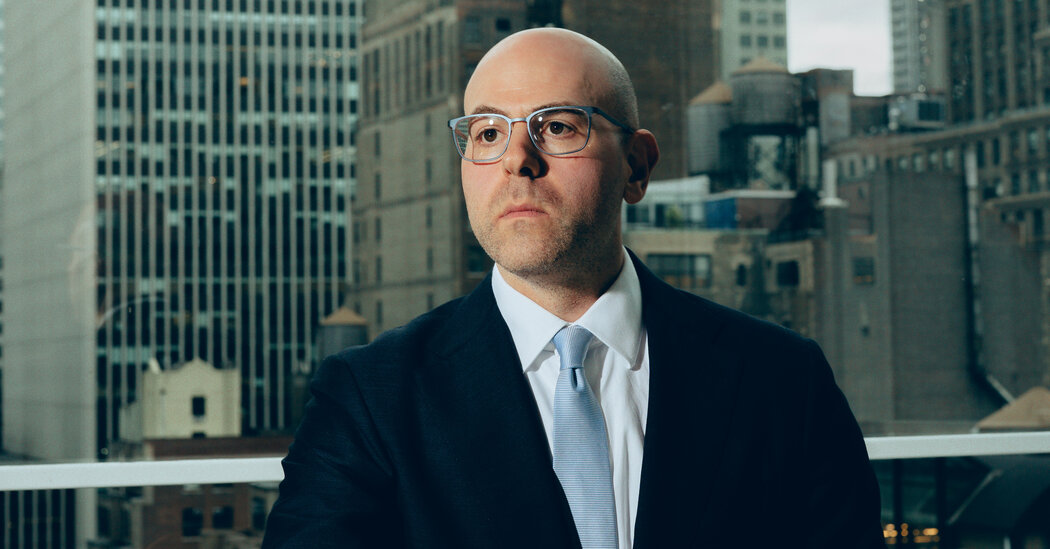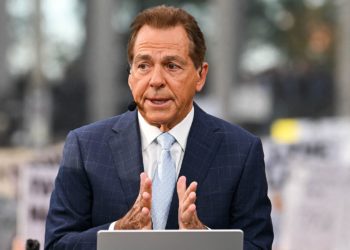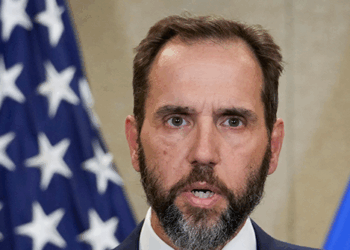Stephen I. Miran, the newest member of the Federal Reserve’s Board of Governors, warned that the central bank risked inducing a recession if it did not swiftly lower interest rates, as he dismissed concerns about elevated inflation.
Mr. Miran, who most recently was a top economic adviser to President Trump, said the central bank should lower interest rates by half a percentage point at its final gathering of the year if the economy evolves as he expects. That is a much more aggressive pace than any of his colleagues at the central bank have supported, even as they have grown more concerned about the labor market’s weakening.
“If you keep policy this tight for a long period of time, then you run the risk that monetary policy itself is inducing a recession,” he said in an interview on Friday. “I don’t see a reason to run that risk if I’m not concerned about inflation on the upside.”
The Fed governor spoke to The New York Times just days after the central bank voted to lower interest rates by a quarter of a percentage point for a second time this year. The decision was more divisive than anticipated, with Mr. Miran voting for a larger, half-point cut and Jeffrey R. Schmid, president of the Federal Reserve Bank of Kansas City, voting for no cut at all.
In a statement on Friday explaining his decision, Mr. Schmid cited concerns about inflation and the fact that it has been running above the Fed’s 2 percent target for nearly five years.
On Wednesday, Jerome H. Powell, the Fed chair, issued a blunt warning that a December cut was “far from” a foregone conclusion, upending widely held expectations that another quarter-point reduction was a near certainty. Mr. Powell, speaking after the policy decision, said officials held “strongly different views” about how to proceed.
Mr. Miran, who was appointed to the Fed by Mr. Trump in August, said in the interview that some of his fellow policymakers expressed a greater degree of worry about Mr. Trump’s tariffs and their impact on overall inflation than he did. He also noted differences regarding the speed at which interest rates should be lowered.
Ultimately, he expects the Fed to reduce interest rates again in December so long as the available data — which is severely limited because of the government shutdown — validates officials’ forecasts that the labor market is softening.
“There absolutely are differing views around the table,” he said. “However, I think we have to pay attention also to the distribution of votes at the table.”
An Unusual Arrangement
Mr. Miran stands apart from his colleagues at the Fed in a number of ways. For one, he is still technically employed by the White House, having taken a temporary leave of absence from his role as chair of the Council of Economic Advisers. The unusual arrangement has drawn backlash, with critics saying it undermines his ability to uphold the longstanding political independence of the central bank.
That separation already appeared under threat amid a litany of attacks from Mr. Trump. The president is now awaiting a decision by the Supreme Court regarding his ability to oust Lisa D. Cook, a Fed governor, over allegations she committed mortgage fraud.
What Mr. Trump wants are substantially lower interest rates and more control over the institution responsible for setting them. Mr. Miran was tapped to join the Fed after a Biden-appointed governor, Adriana D. Kugler, unexpectedly stepped down before her term was set to end in January. The Trump administration is also vetting candidates to succeed Mr. Powell, whose term as chair ends in May.
Mr. Miran on Friday defended his decision not to resign from his White House job, saying that it was a “very short tenure” and that the confirmation process is “lengthy and stressful.”
Mr. Miran also sought to downplay concerns about whether his dual employment situation undermined the public’s perception that the Fed operated independently.
“The people who have made those criticisms, they’d be making exactly the same claims about me if I had fully resigned from C.E.A.,” he said. “Their minds were already made up.”
Mr. Miran defended the Fed’s ability to set monetary policy free from political interference, which he said included how the central bank manages its $6.6 trillion balance sheet. But he also said it required the central bank to “stick to our knitting and make policy for monetary purposes and monetary purposes alone.”
Asked about any plans to stay on at the central bank beyond January, Mr. Miran said he was “not going to speak to hypotheticals at the moment.”
The Case for Big Cuts
When it comes to questions about the economy and the policy outlook, Mr. Miran has carved out his own path as well.
Like many of his colleagues, he is worried about the labor market, which has slowed considerably in recent months. Keeping interest rates elevated can make the economy “more brittle to different shocks,” he said.
What he is far less concerned about is inflation. Mr. Miran does not believe tariffs are driving a meaningful amount of inflation. Nor does he think they will in the future, even though companies warn that their ability to shield their customers from higher costs may soon be maxed out.
Mr. Miran said he expected foreign suppliers to bear the burden of the levies, but conceded that right now companies that facilitate trade between the U.S. and exporters — even those in the United States — are facing tough decisions.
“There’s an assumption that just because the wholesaler is paying the tariff now and facing reduced margins as a result, that in the end they’ll have to pass that on to the consumer,” he said. “I don’t really expect that to happen. I expect the wholesaler will go back to the exporting country and say, ‘You’re going to cut your prices, or else I’m going to have to source this product from somebody else.’”
When asked about products that cannot be made domestically, Mr. Miran said that even if prices rose, it would not translate to higher inflation.
A primary pillar of Mr. Miran’s inflation argument is the housing market. Citing the sharp drop in immigration as a result of Mr. Trump’s crackdown, Mr. Miran said fewer people competing for a relatively fixed supply of housing should lower rents and other related costs. He rebuffed the idea that removing a large number of people who often work in the construction industry could be an impediment, saying underemployed younger Americans could be hired instead.
“If immigrant workers are no longer abundant, I don’t understand why it wouldn’t be the case that you’d be able to tap labor supply from other parts of the labor market,” he said.
Another cornerstone of Mr. Miran’s stance in support of much lower borrowing costs rests on his view that the level of interest rates that neither speeds up growth nor slows it down — known as the neutral rate — is much lower than most central bank officials think. He has argued for interest rates to be closer to 2.5 percent, well below the current range of 3.75 percent to 4 percent.
Just last year, Mr. Miran was arguing the opposite, saying the neutral rate was higher than Fed officials had appreciated. But over the course of the year, he said, policy changes enacted by the Trump administration involving immigration restrictions, tariffs and taxes changed his thinking.
Many economists have said that if the neutral rate is as low as Mr. Miran assumes, the economy should be showing greater signs of strain. But the unemployment rate has stayed relatively stable, consumers are still spending and stock markets continue to notch new records. They also stressed that a low neutral rate is typically associated with a stagnating economy, rather than booming one.
“It’s not the case that if policy is so restrictive right now that I necessarily would have expected to see that materialize in a sharp downturn in the economy,” Mr. Miran countered. “I expect a sharp downturn to materialize in the economy in the future if policy remains this restrictive.”
He also said a lower neutral rate did not necessarily mean lower potential growth for the economy. If deregulation, for example, allows the United States to produce more with the same number of people, he said, there could be a divergence between the two. Other economists argue that, in general, higher growth should translate to a higher neutral rate.
Mr. Miran maintained that he was open-minded on all of these fronts and said that if his forecasts did not pan out, he would adjust his stance on how much interest rates needed to fall. That applied not only to his thinking around housing inflation, but also if, for example, the Supreme Court struck down Mr. Trump’s tariffs. Mr. Miran had previously said tariff revenue would help to bring down the deficit, which in turn translated to a lower neutral rate. Analysis conducted by the nonpartisan Congressional Budget Office, however, projects the deficit will soar to new heights in the coming years.
“If we didn’t have those shocks, then neutral wouldn’t move,” he said.
Colby Smith covers the Federal Reserve and the U.S. economy for The Times.
The post Fed Risks a Recession if It Doesn’t Cut Rates Rapidly, a Top Official Warns appeared first on New York Times.




